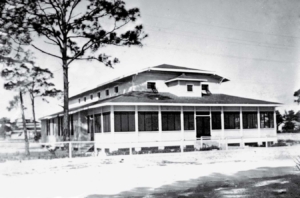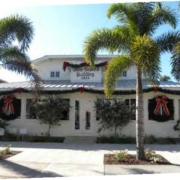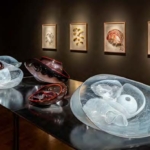The Central Voice of Naples History by Lila Zuck, Naples Historical Society Historian

The Naples Company Building c1926.
In a letter dated July 3, 1924, John S. Jones, then at the helm of the Naples Improvement Company, the development arm of The Naples company, and promoter of bringing Atlantic Coast Line rail service to Naples from Fort Myers, commissioned William Cambier, Chief Engineer of Tamiami Railways to design a building for company offices to be constructed on the northwest corner of Broad Avenue South and Third Street South, the northern perimeter of the two-acre Hotel Naples parcel.
Construction was completed in January 1925, and the building, known thereafter as The Naples Company Building, opened. In addition to company offices, the building served as a community hall, offered a movie theater, a soda fountain, a cigar stand, a reading room, a screened porch where nondenominational church services were held, and a room available to Naples Town Council for council meetings.
In 1978, Charles A. Camalier, Jr. purchased the original two acre hotel parcel from Henry Watkins, Sr., owner at the time, for future development as the Plaza on Third, completed in 1988. Based on the aerial photograph, a small structure was constructed adjacent to The Naples Company Building between 1958 and 1964.

Above, this 1964 aerial view of the building reveals the adjacent small structure, with two Broad Avenue facing windows.
By 2012, when this photograph was taken, an ivy vine had covered the structure, still standing in 2020. The Camalier Family has preserved and  will preserve The Naples Company Building. Unfortunately, as of 2020, the smaller structure is slated to be removed for the impending development of the surrounding parcel.
will preserve The Naples Company Building. Unfortunately, as of 2020, the smaller structure is slated to be removed for the impending development of the surrounding parcel.
Over the years residents remember the small building as being the studio of local photographer, Tom McGrath, followed by the studio of photographer Ernest Burlingame in 1965, a tennis shop in 1984, a gallery established by local artists called Local Color, followed by the gallery of local artist Paul Arsenault, and finally the wine room of Fantozzi’s of Olde Naples until 2006, after which time the structure remained vacant.
Naples Historical Society is the Central Voice of Naples History and operates Historic Palm Cottage™ a 3500 square foot house museum opened to the public throughout the year. This article is part of the Society Sage Stories series prepared exclusively for this publication. It is based primarily on the book Naples, A Second Paradise: The History of Naples, Florida (2010).
For more information go to www.NaplesHistoricalSociety.org.




Leave a Reply
Want to join the discussion?Feel free to contribute!